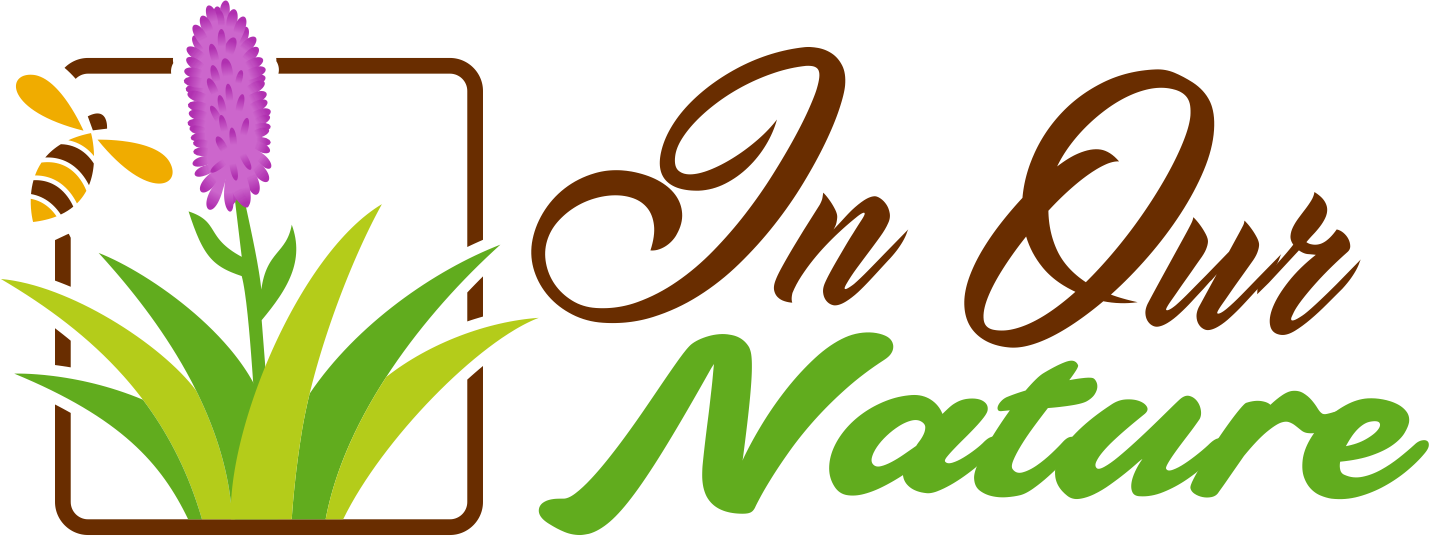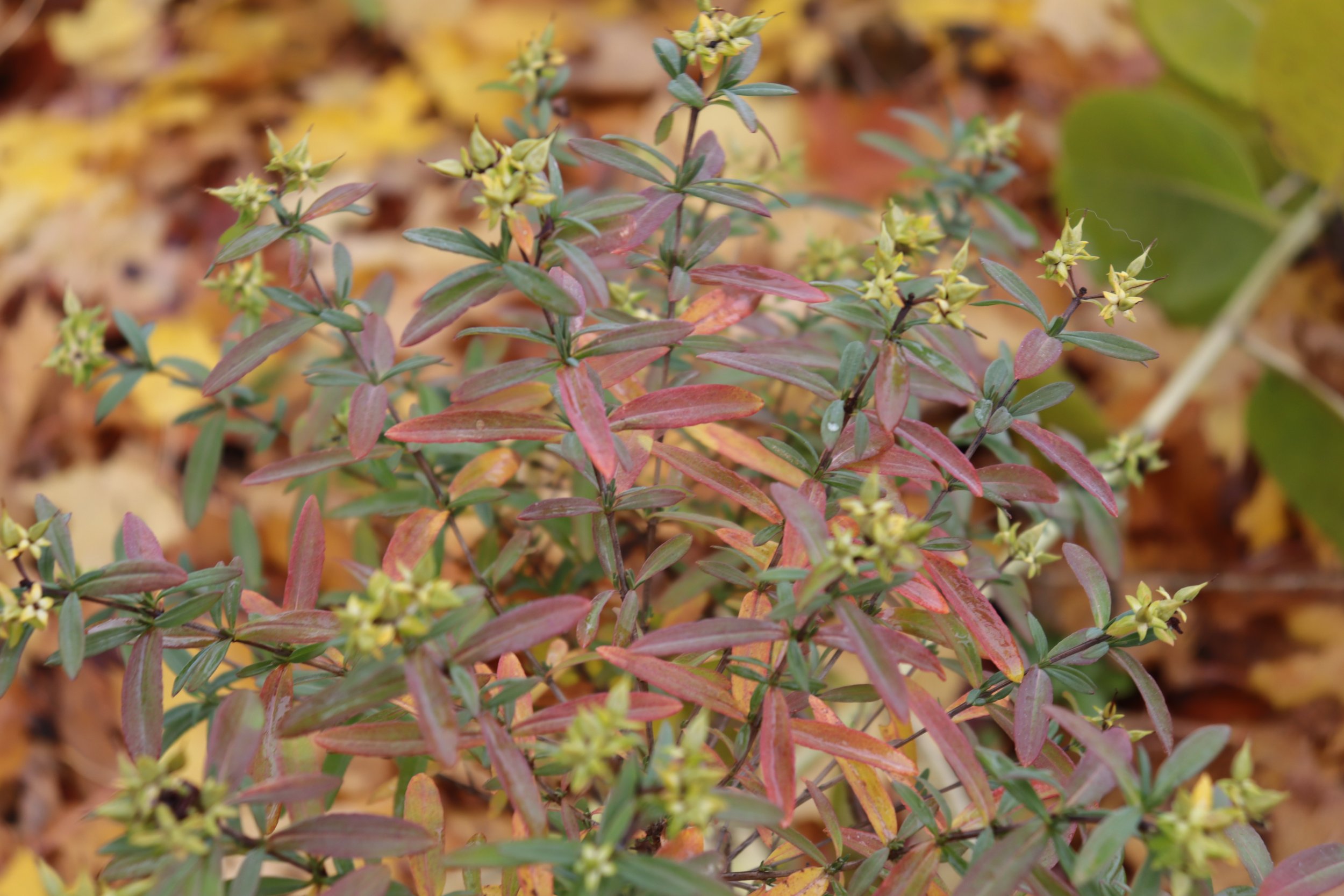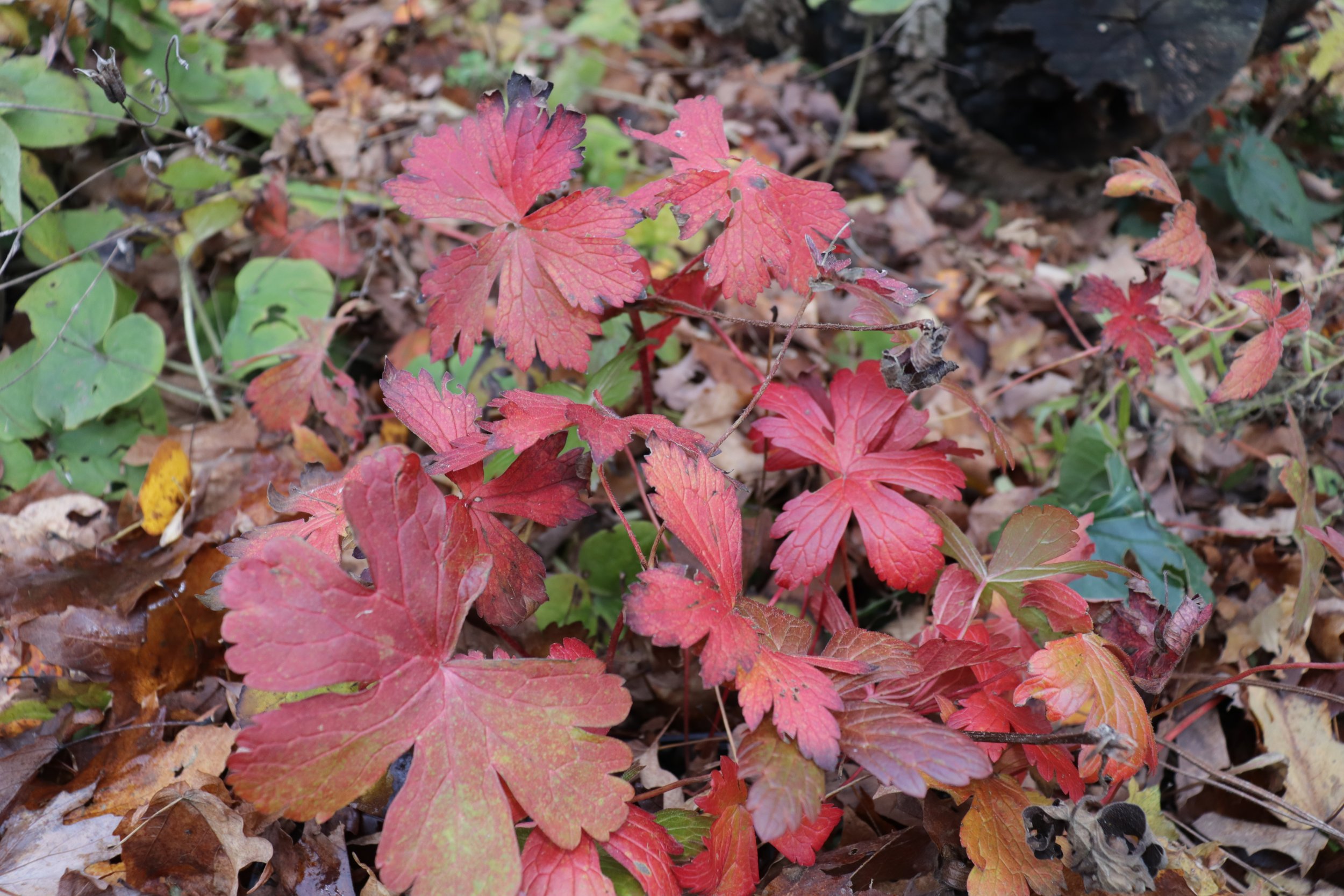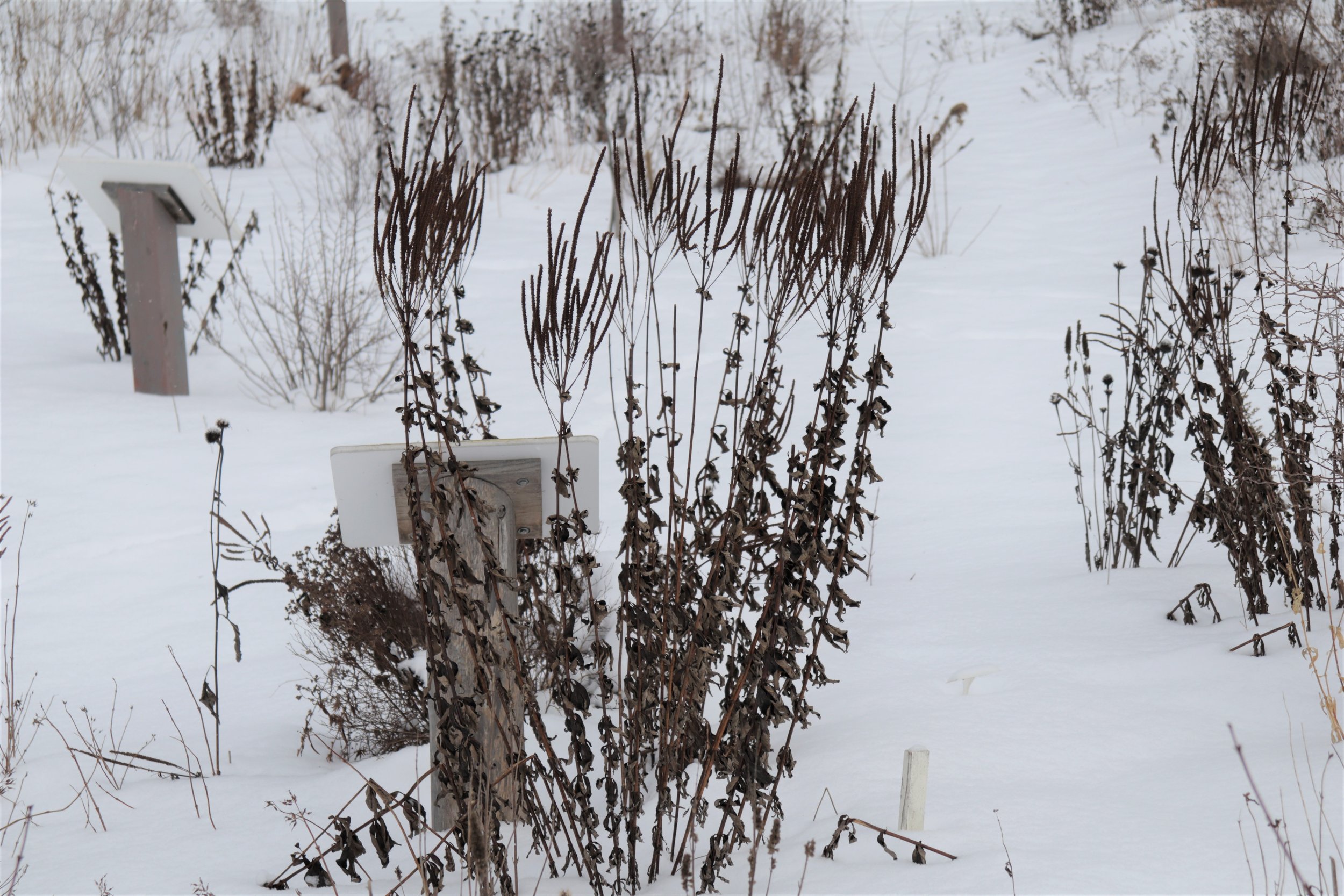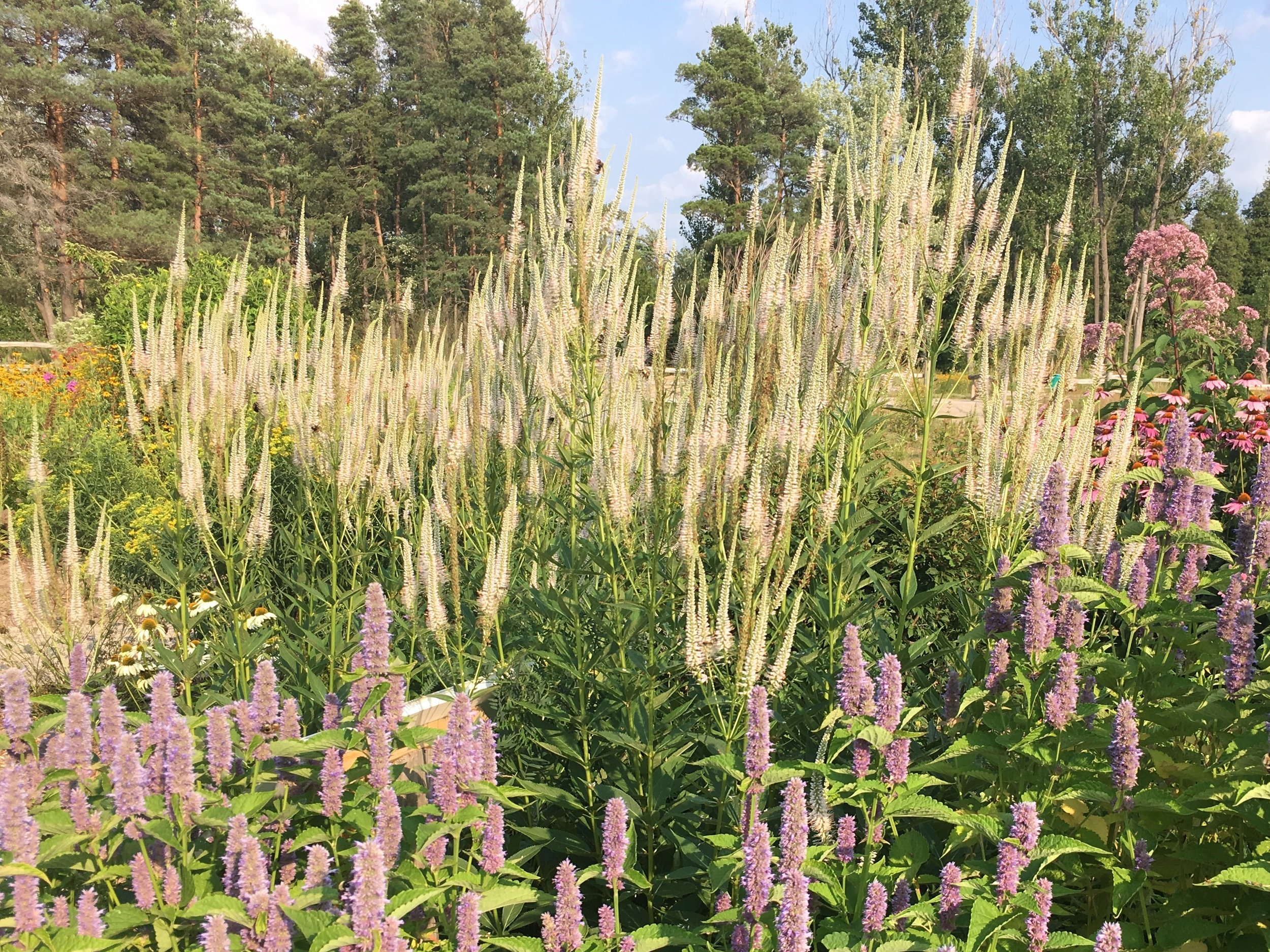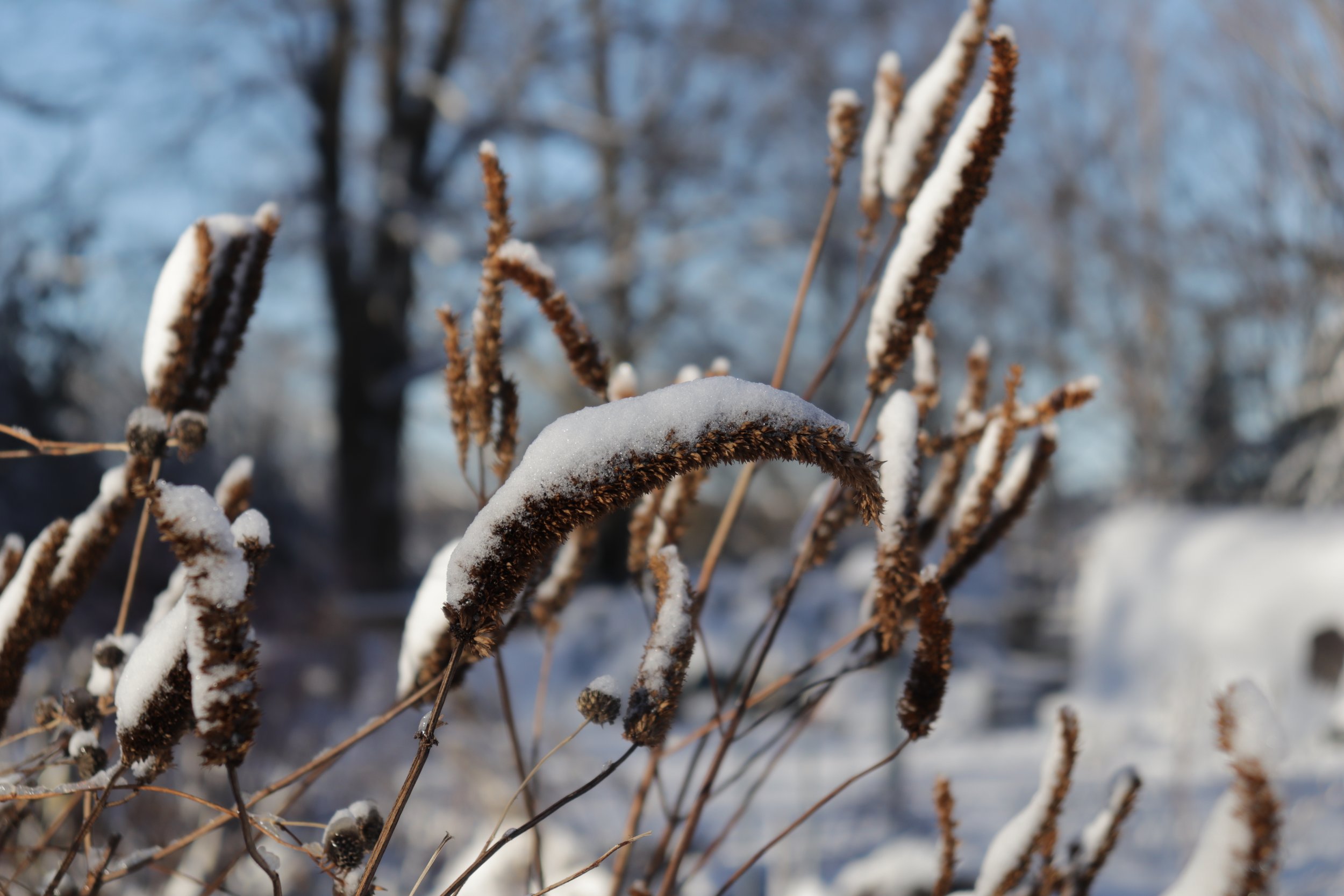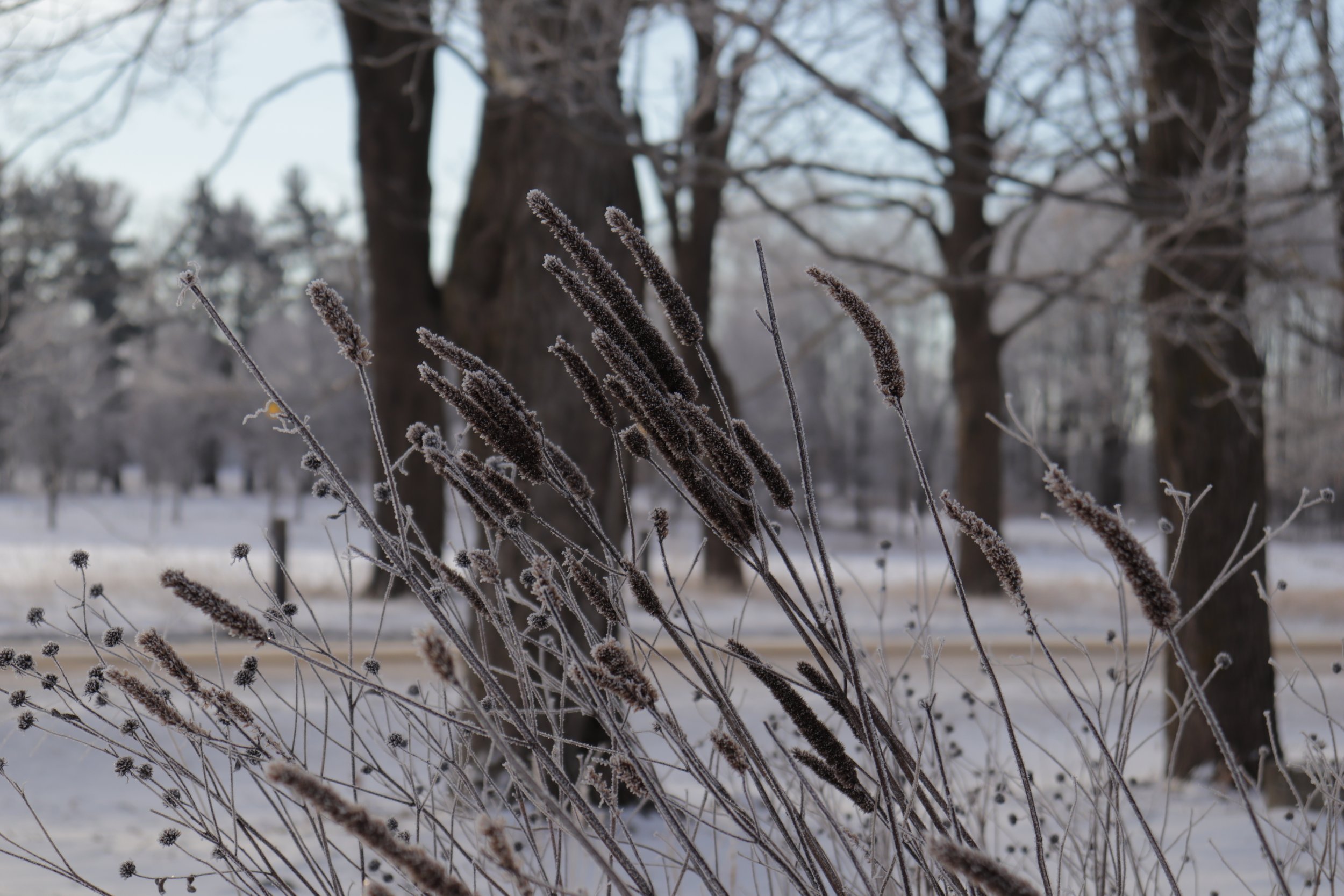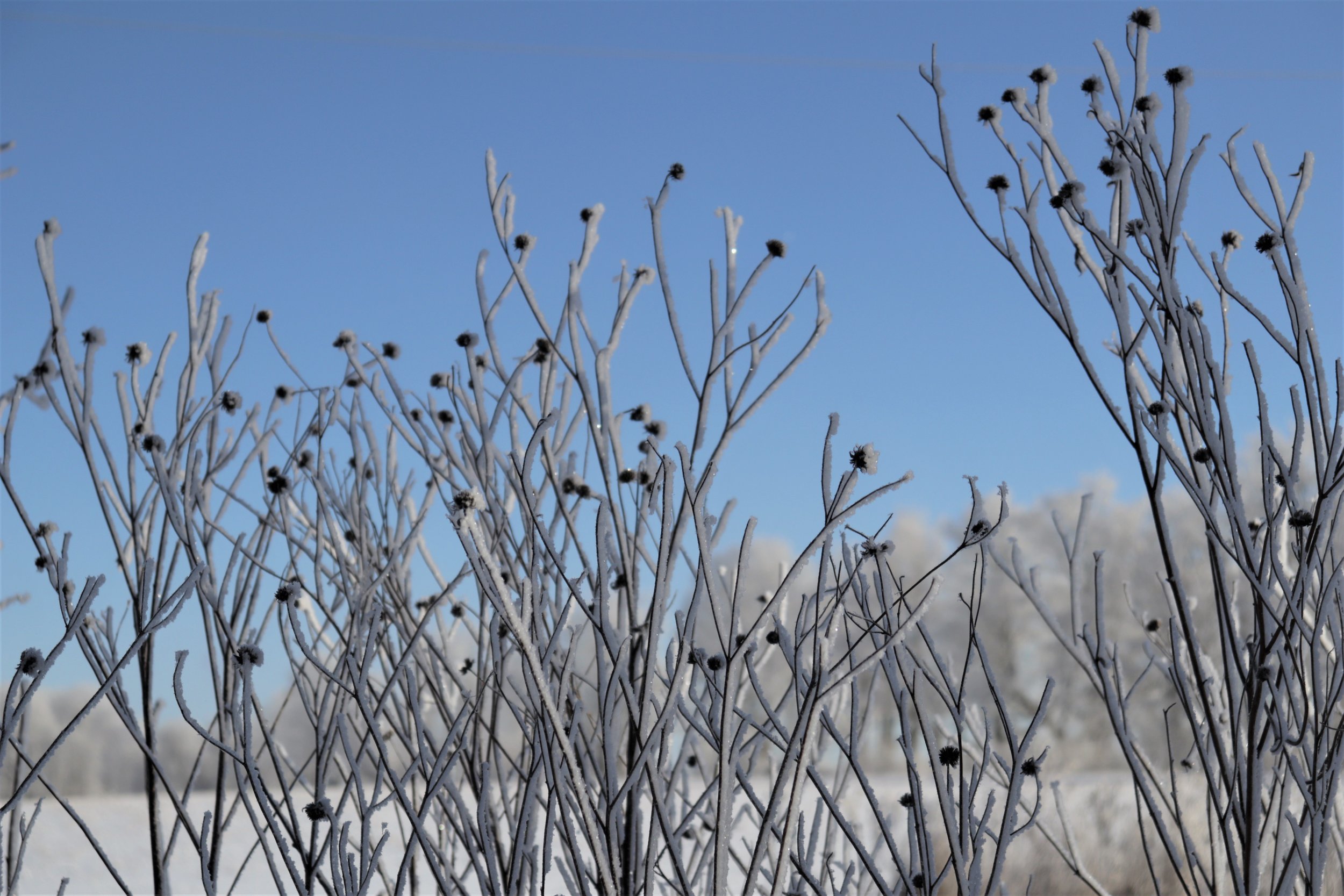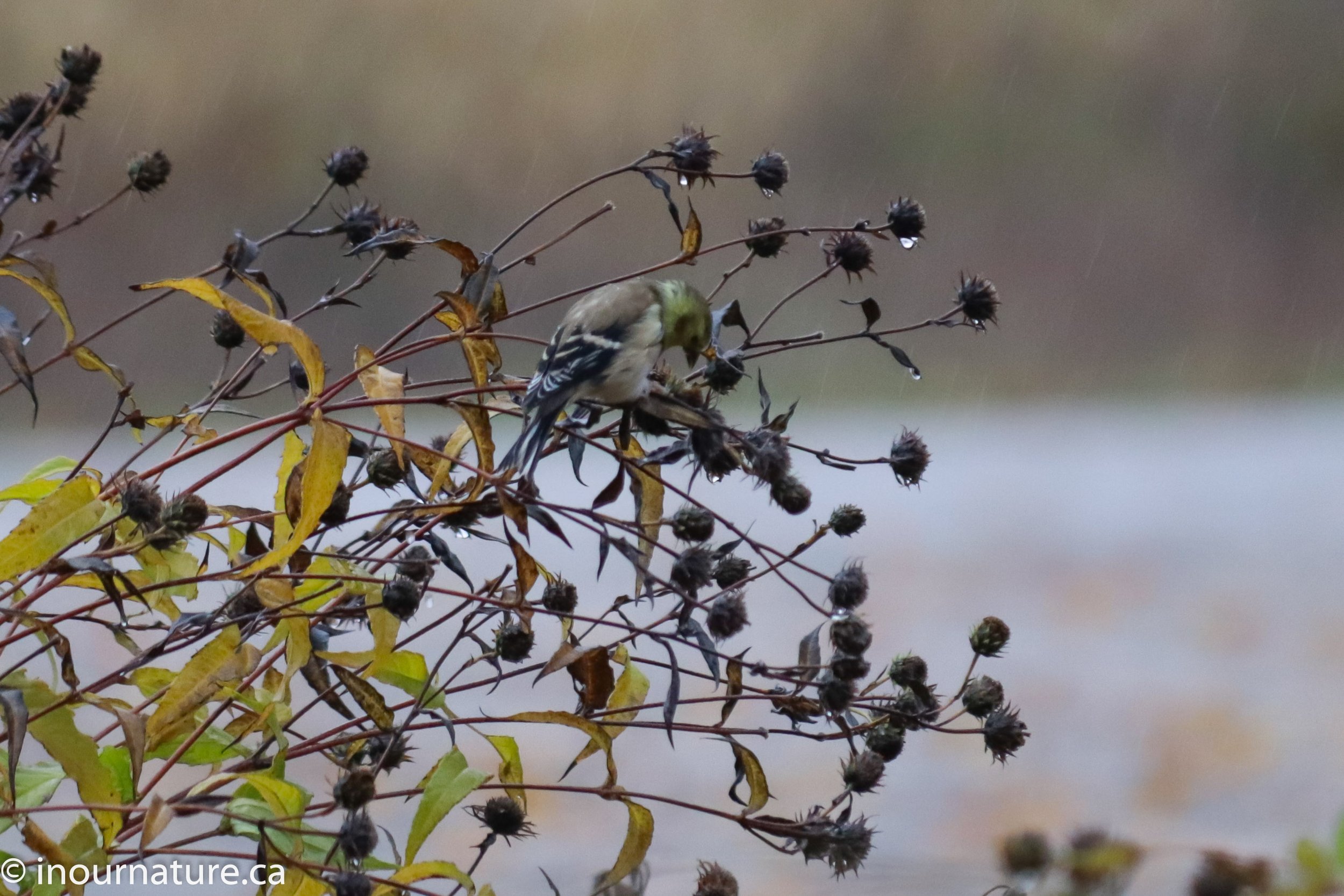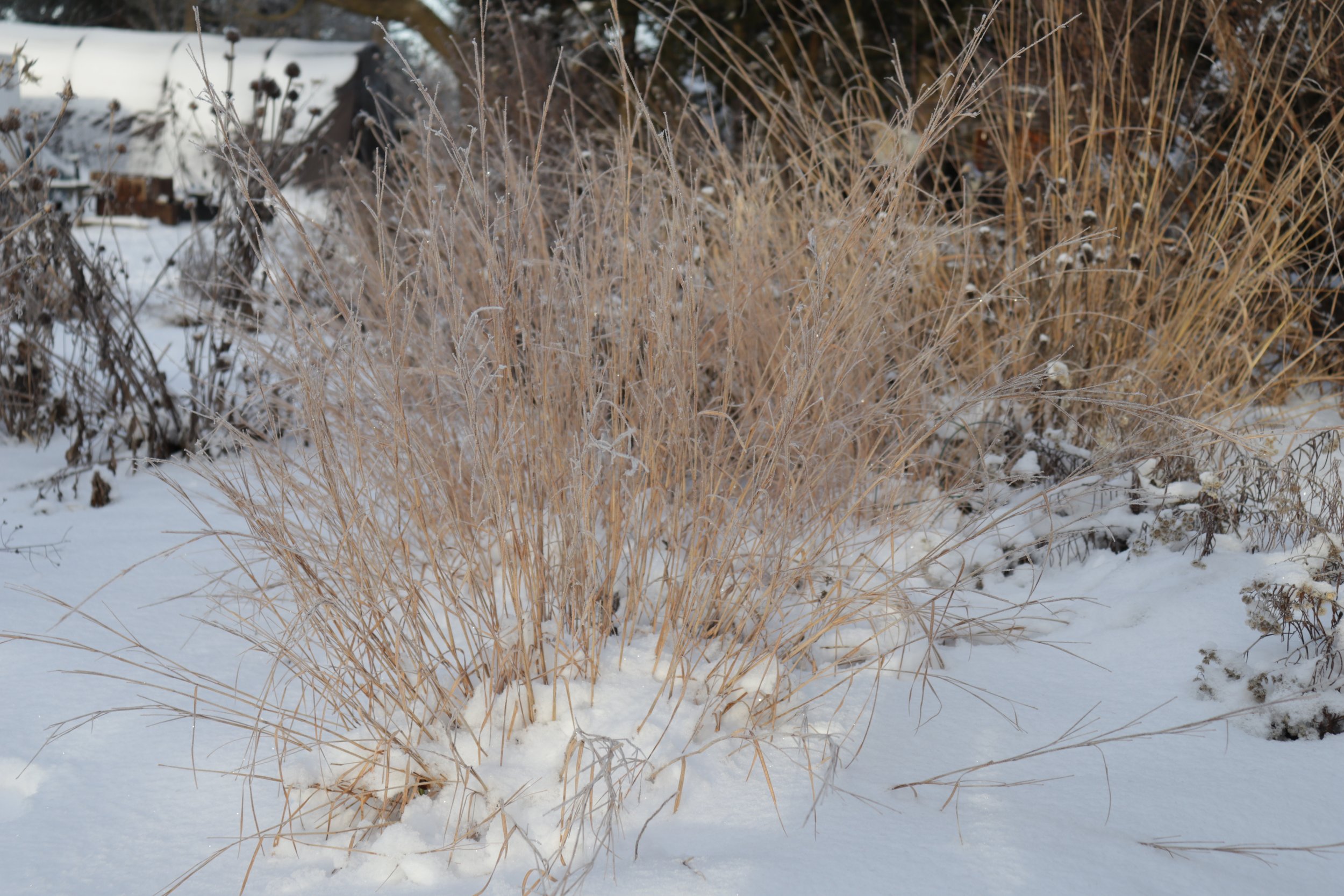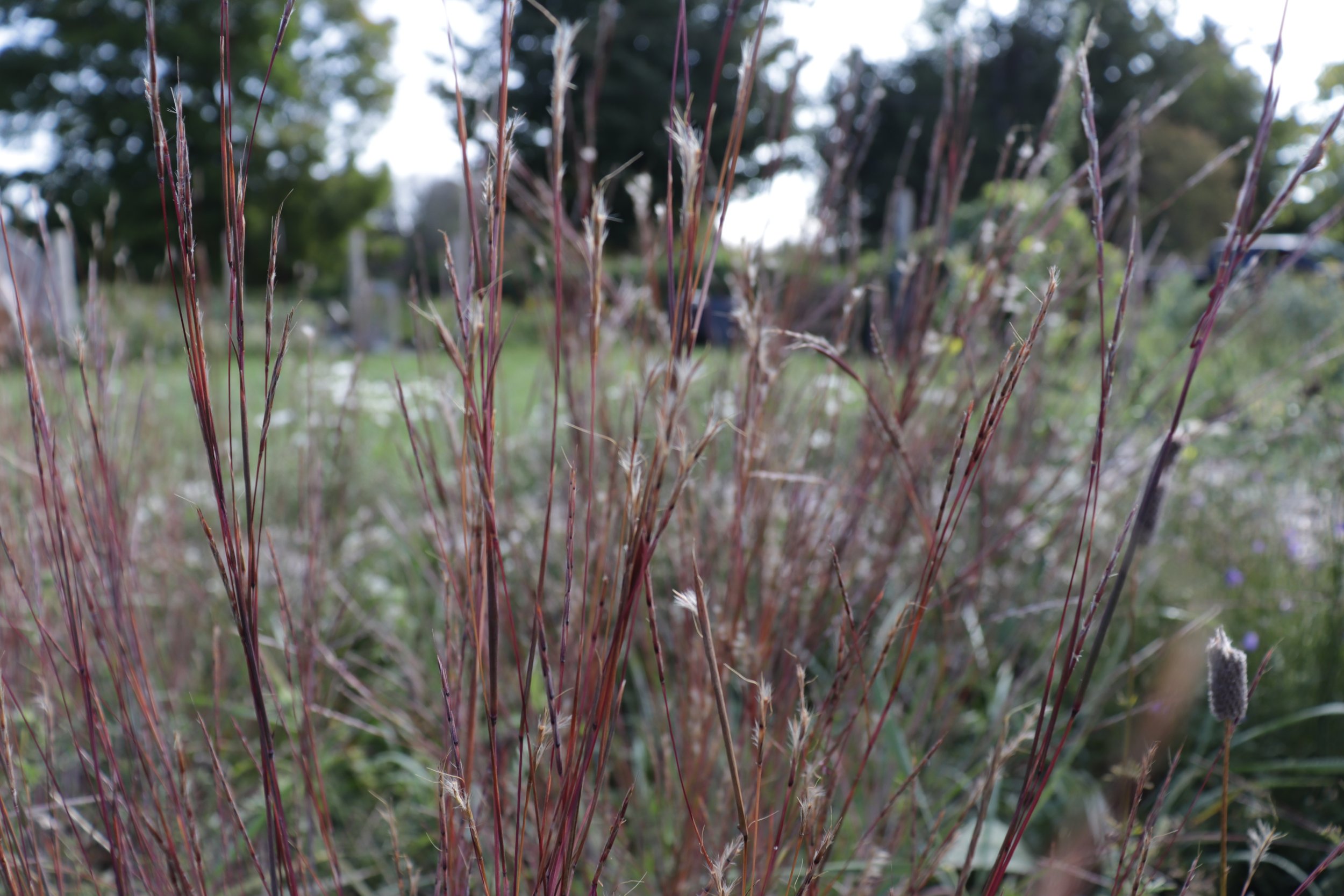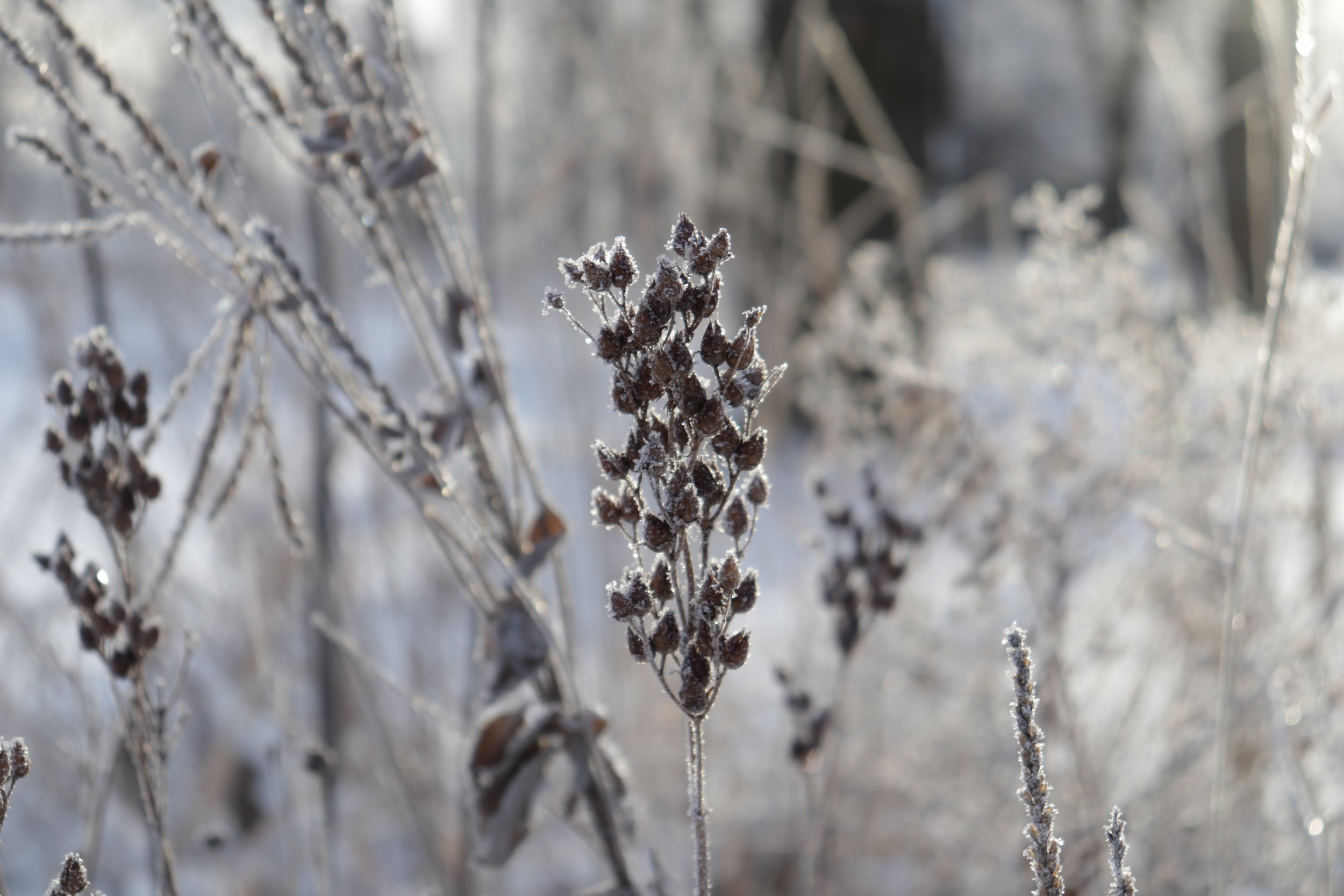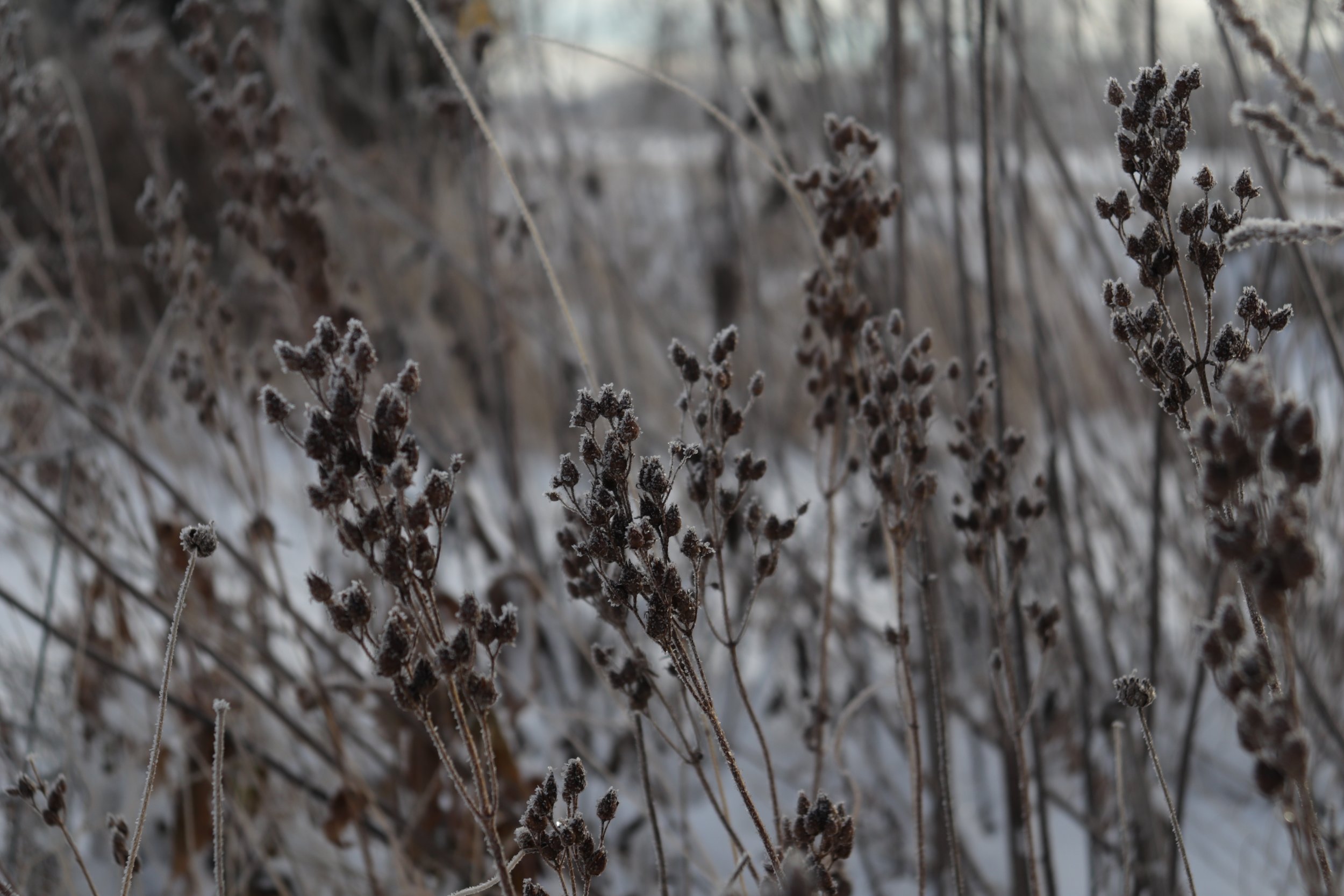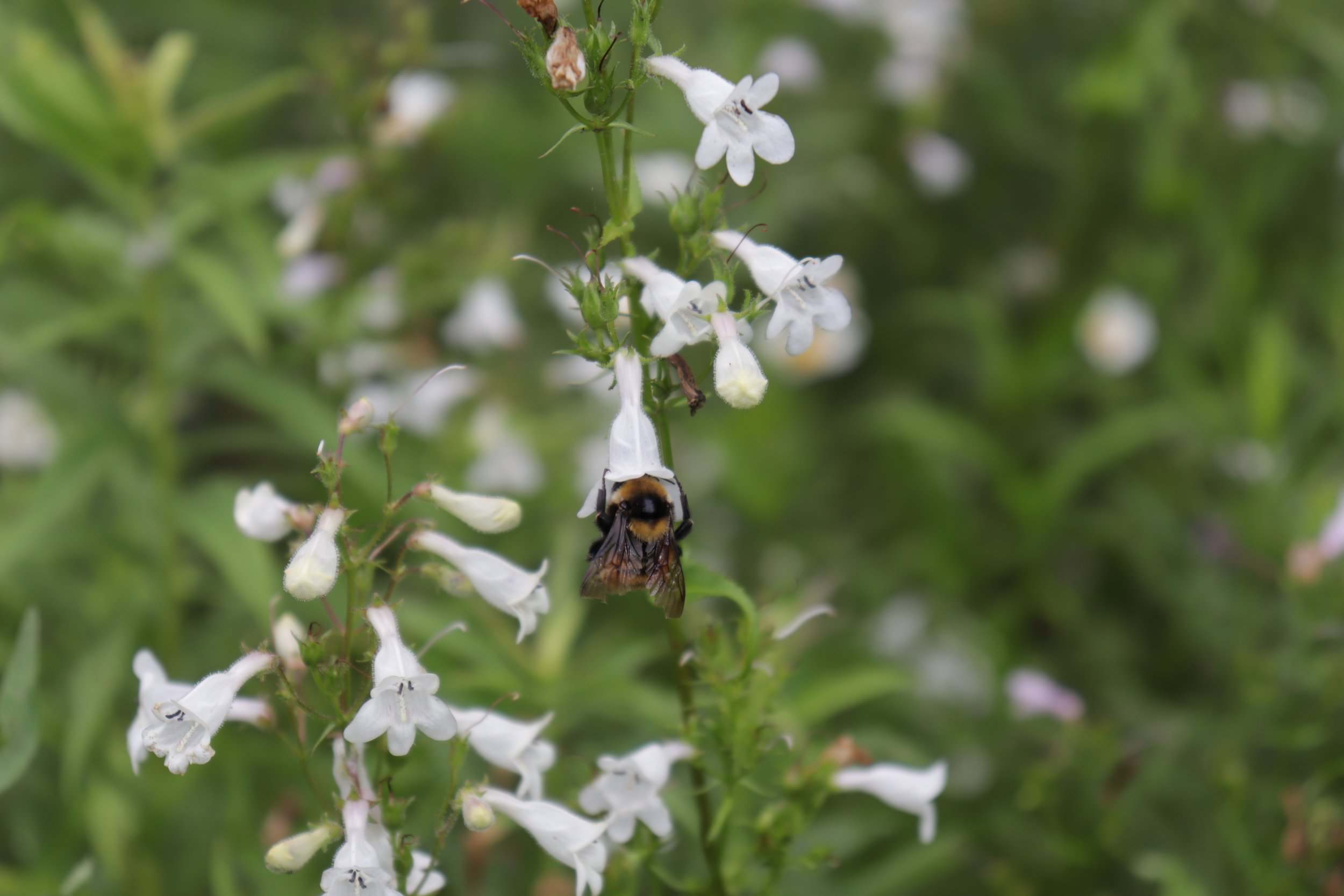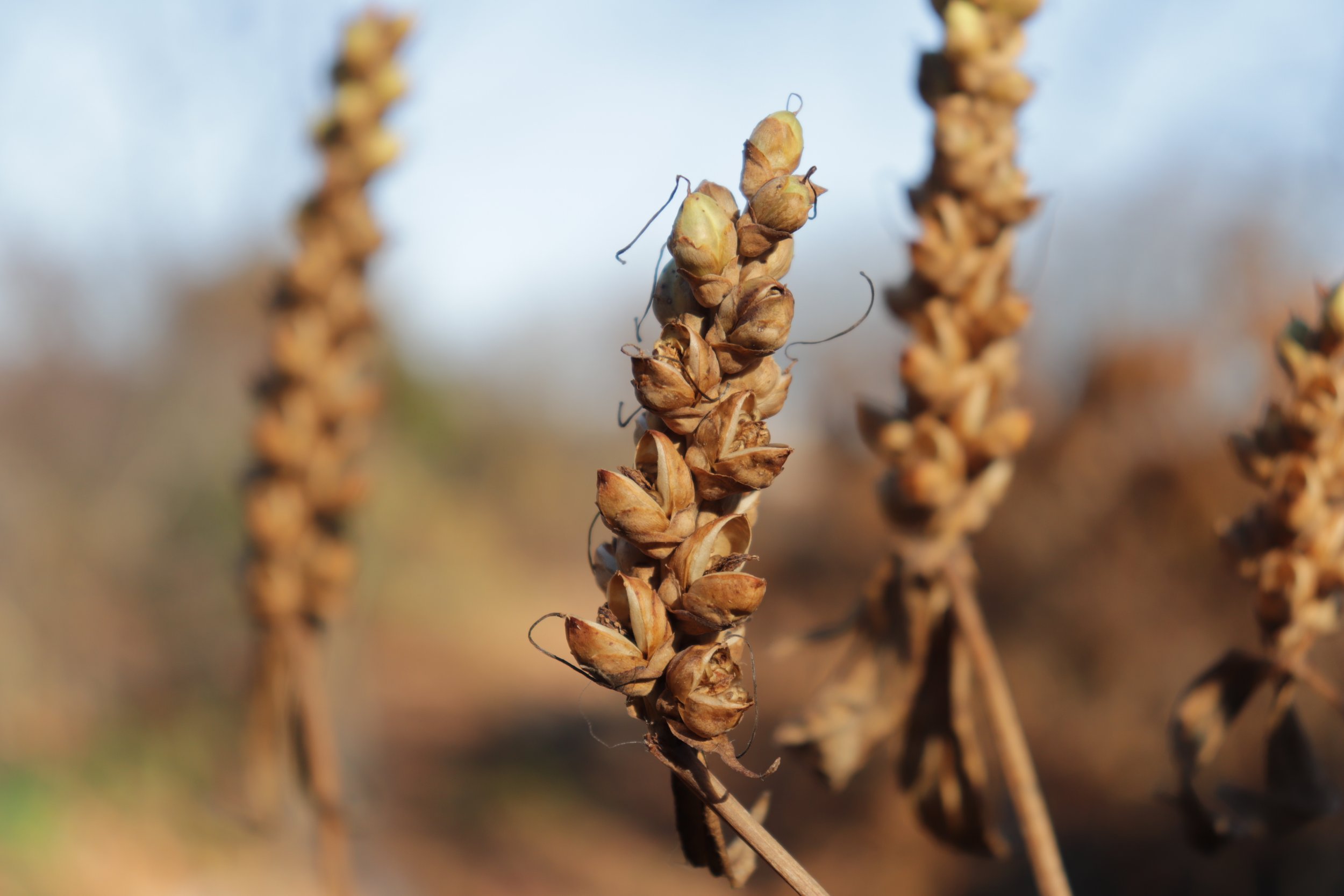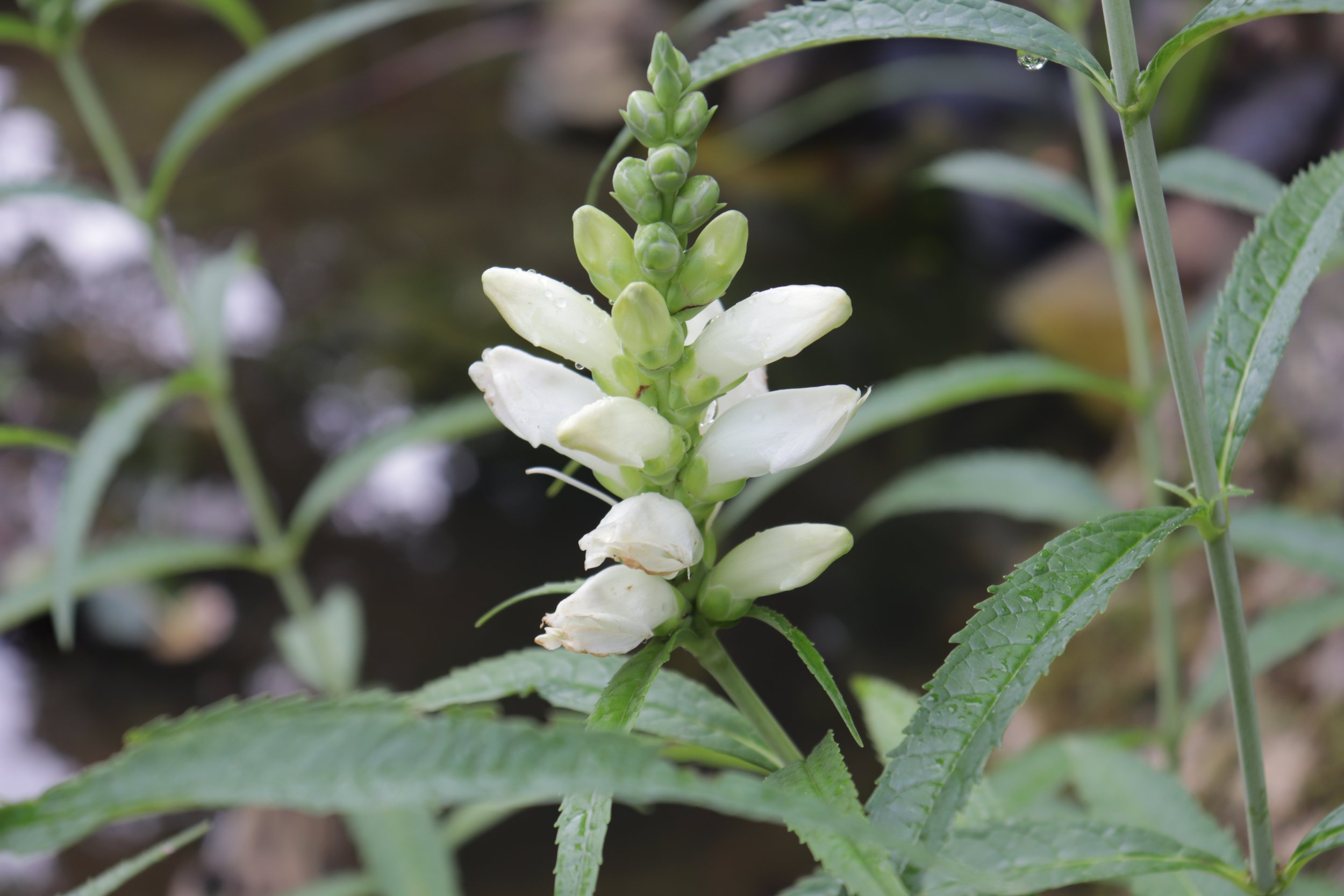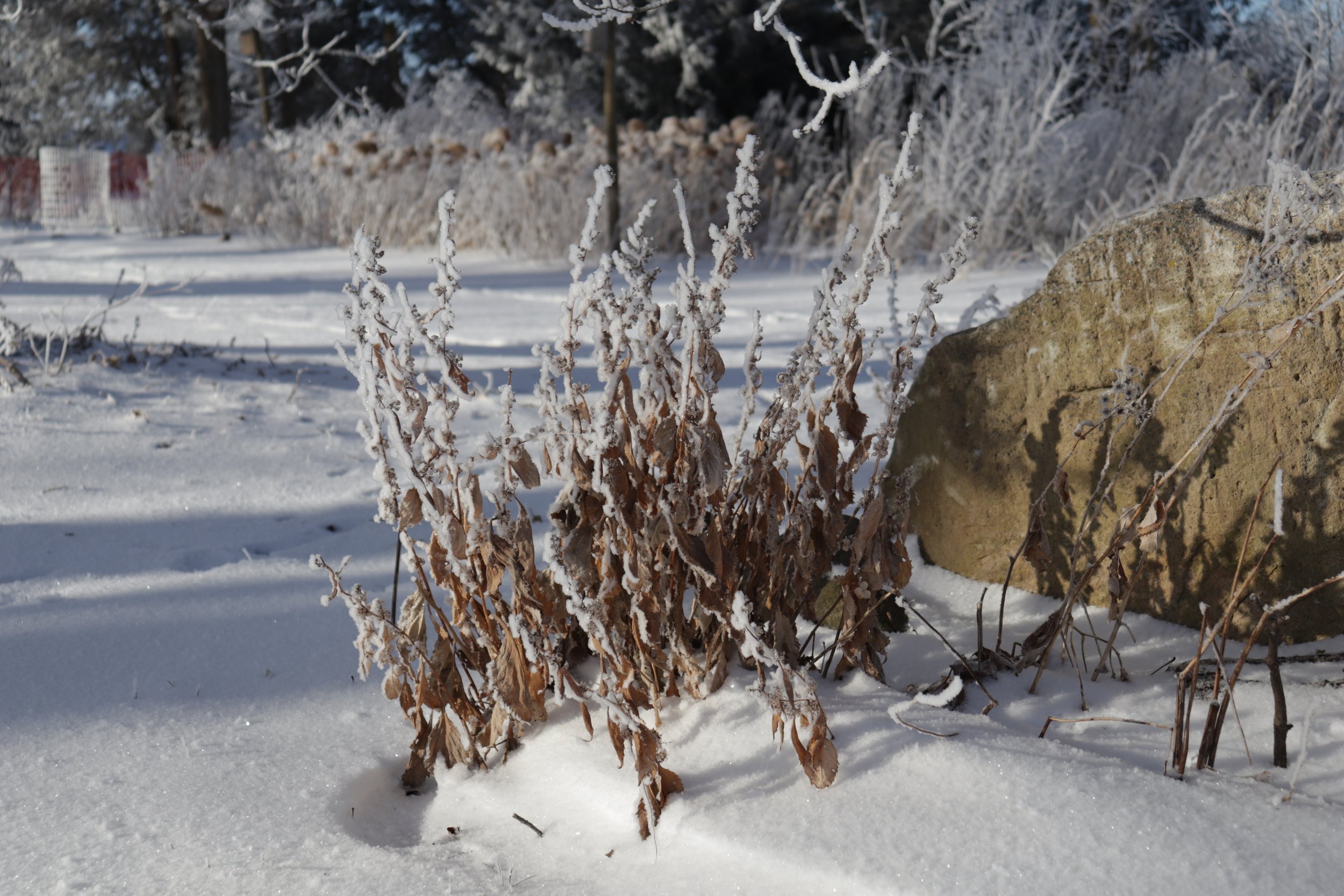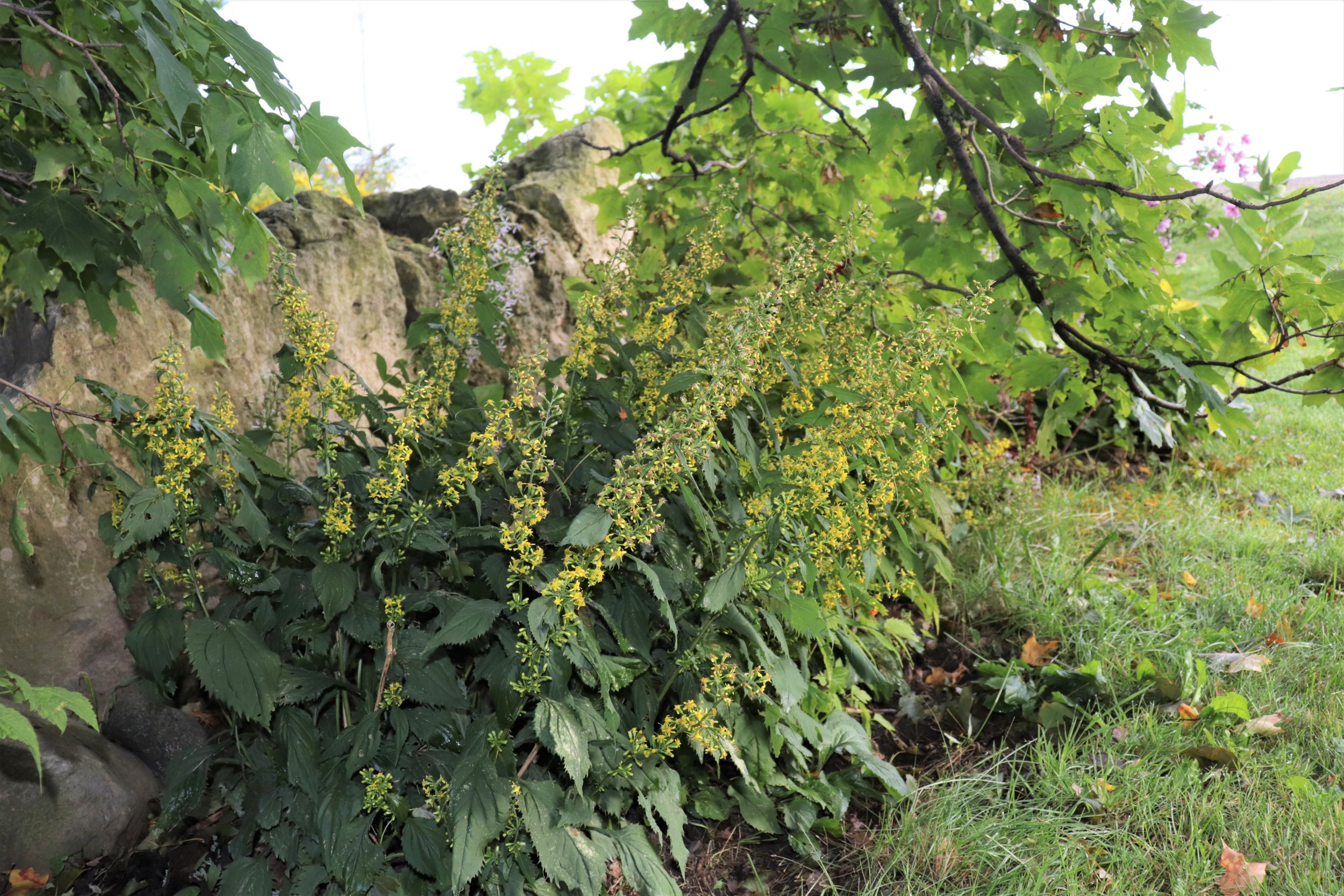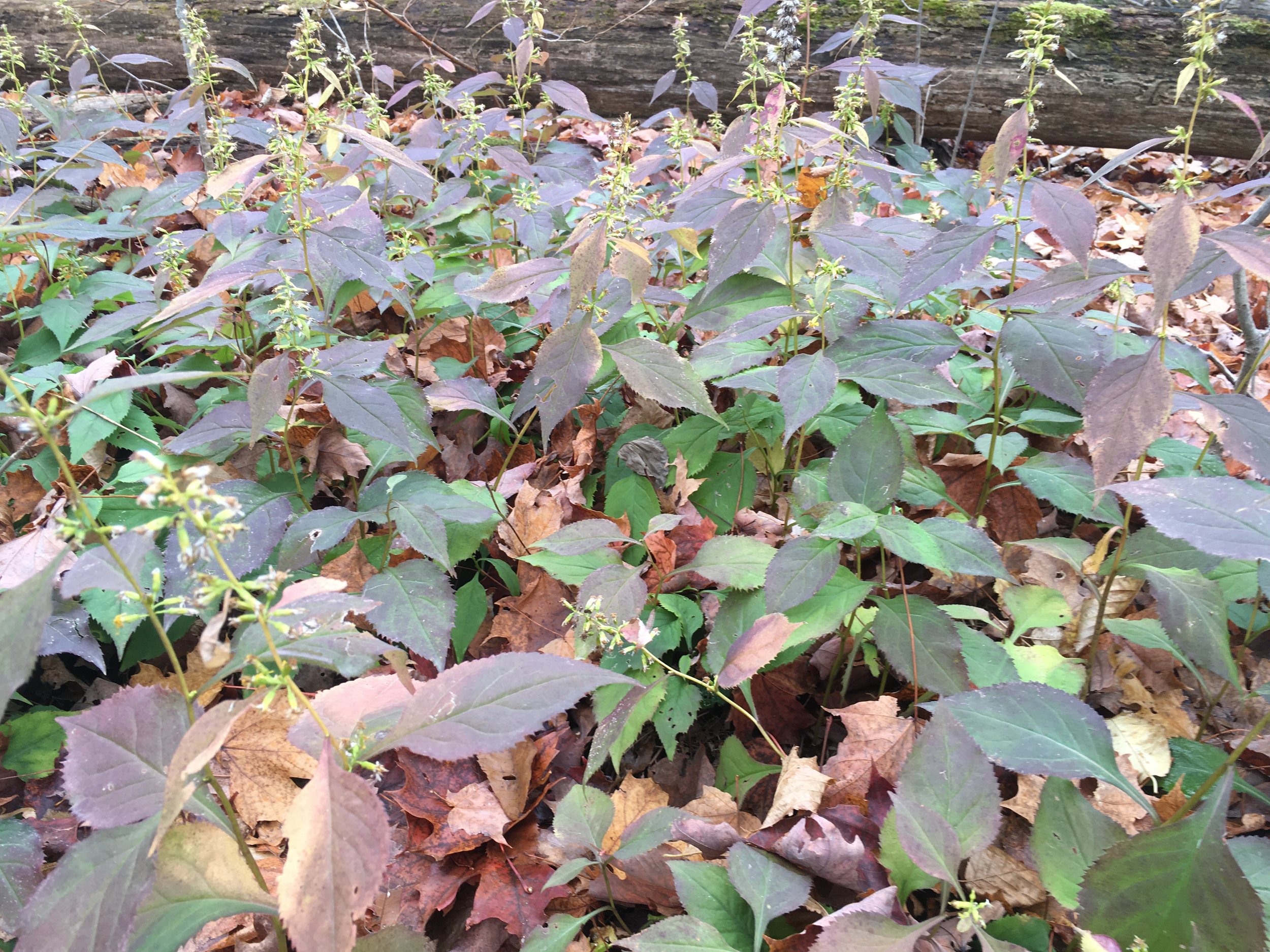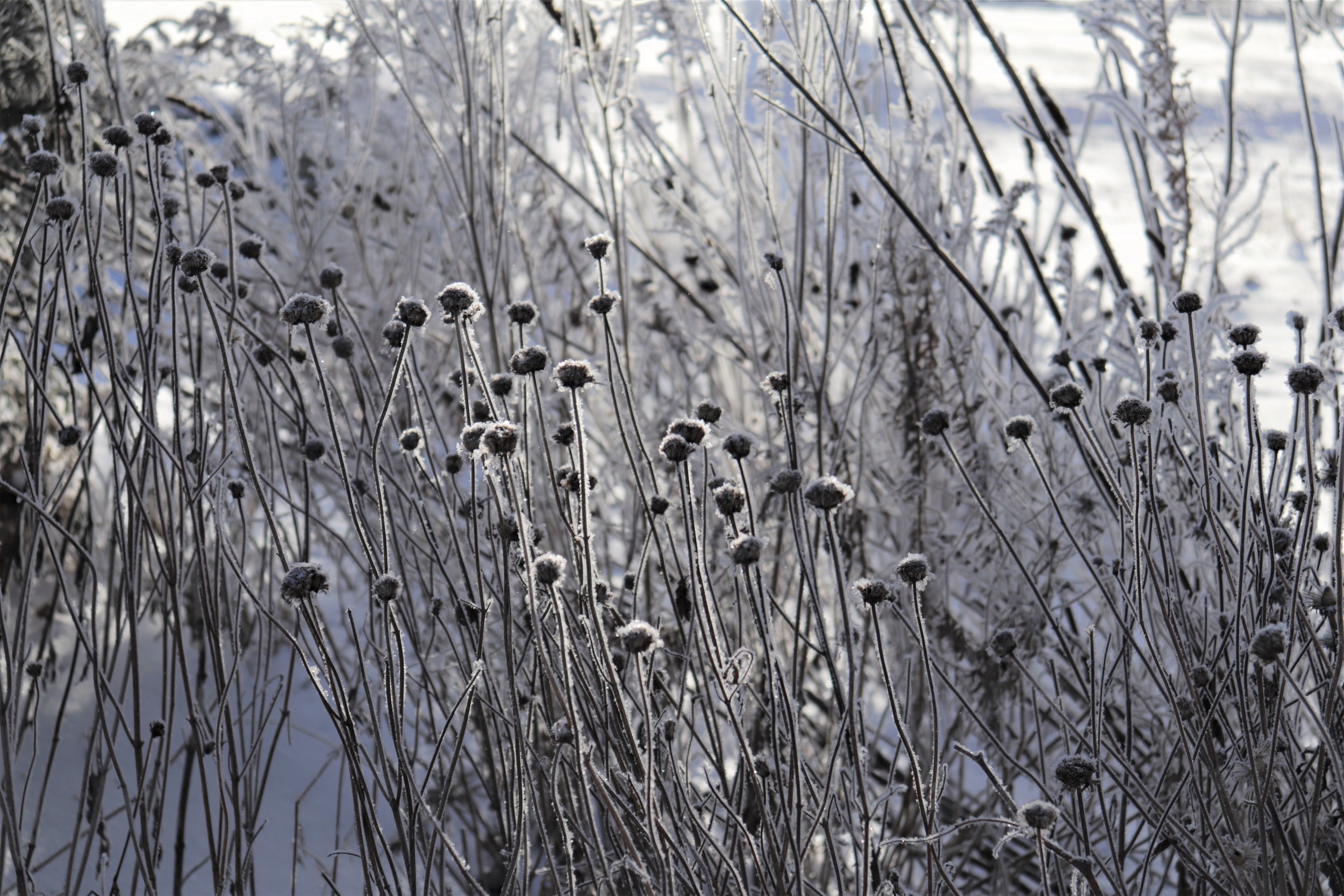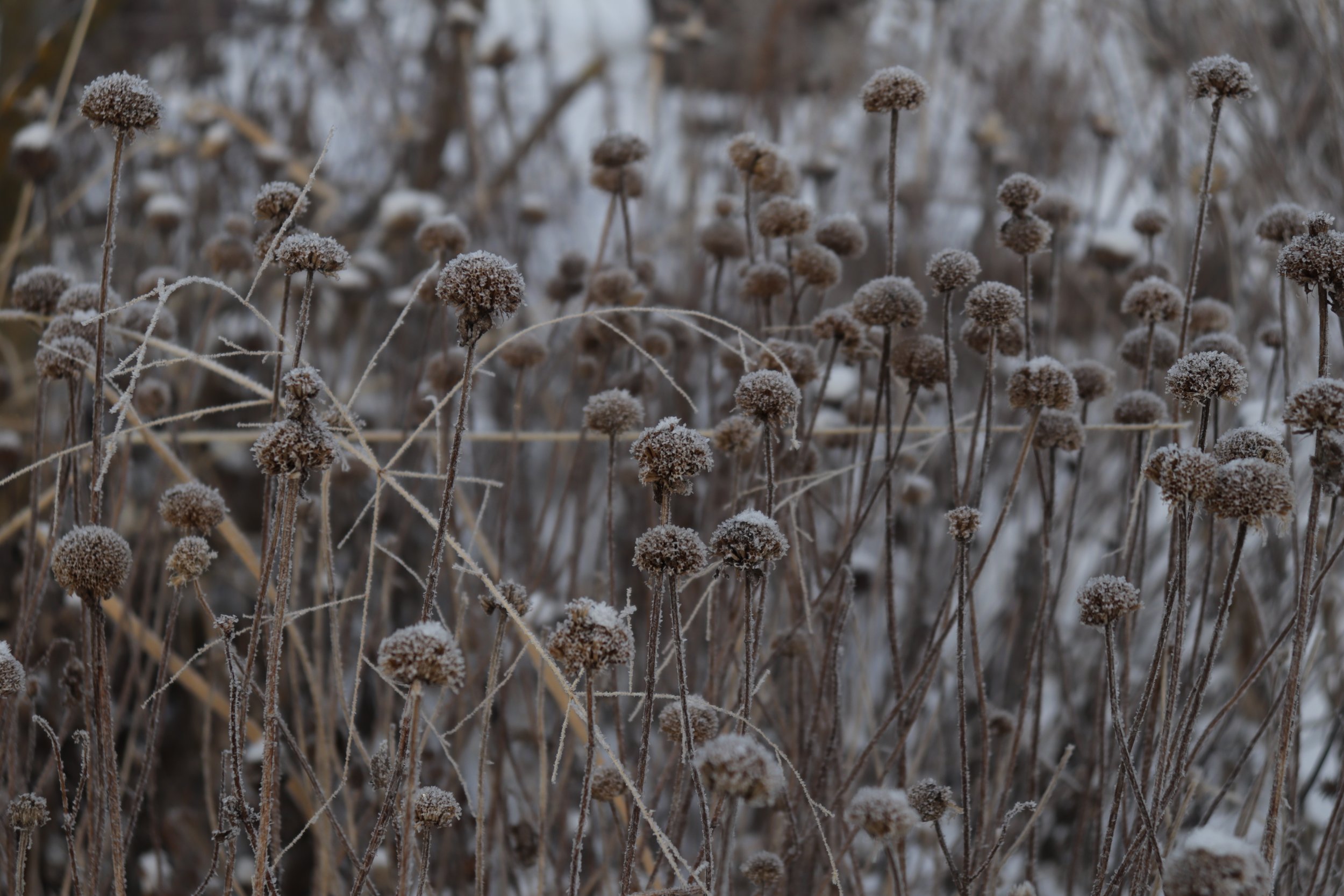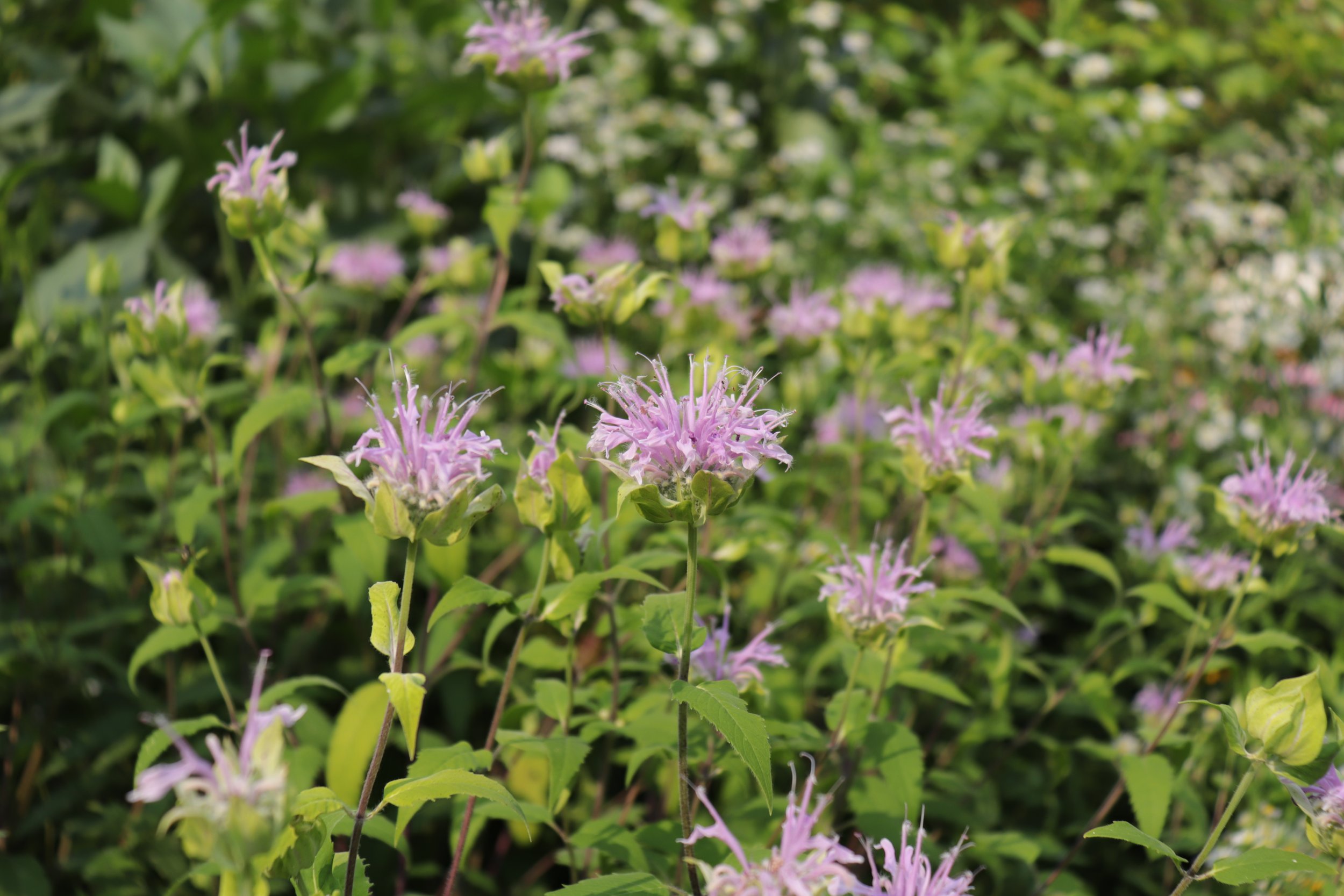Native Plants for Stunning Winter Interest
The ever-evolving colour palettes of spring, summer and fall blooms capture our interest while providing sustenance for both our souls and the wildlife we share our yards with. Yet, all too often I see gardeners enthusiastically plan for these three seasons then, in anticipation for winter weather, proceed to cut their plants back once the last flower has faded.
However, at In Our Nature, we strongly believe that garden interest doesn’t fade with the last flowers of fall. Even as flowers fade, our perennial gardens can put on a fireworks display of colour that competes even with the changing tree leaves around them. Some of the most noteworthy displays come from the fiery red hues of Wild Geranium or the rainbow sherbert-coloured leaves of St Johns Wort. Foxglove Beardtongue turns stunning hues of burgundy-red while Closed Bottle Gentian leaves fade to rich shades of purple, reminiscing of the fall colours of the majestic White Ash.
When we leave our plants standing through all seasons, interest does not fade with the last flowers of the year, but rather, it transitions into the warm hues of fall then once again into more subtle earth tones of winter.
This transition of seasons is a natural process to be embraced in the garden because it provides us with dynamic landscapes where we can appreciate plants not only for their flowers, but for their structure, form, leaf colour and texture - the true essence of a winter garden.
Standing plants are also lifelines for the wildlife that we share our yards with. Gardeners who get through winter months by watching Dark-eyed Juncos and other winter-hardy birds know that a winter garden is about so much more than just visual interest. Read on about why wildlife need you to leave your garden cleanup until the spring.
Top Native Perennials for Winter Interest:
Culvers Root (Veronicastrum virginicum)
Giant Purple Hyssop (Agastache scrophulariifolia)
Woodland Sunflower (Helianthus divaricatus)
Little Bluestem (Schizachyrium scoparium)
Foxglove beardtongue (Penstemon digitalis)
Turtlehead (Chelone glabra)
Zigzag Goldenrod (Solidago flexicaulis)
Wild Bergamot (Monarda fistulosa)
Culvers Root (Veronicastrum virginicum)
Culvers Root rises up to 1.5m tall and in late summer, shows off with candelabrum-like spires of white flowers that are always buzzing with bees. The flowers eventually fade into long, slender seed heads borne on straight stems, adding a strong vertical presence to the winter garden.
The upright, clumping form and sturdy stems of Culvers Root make it a highly desirable winter interest plant that will often stand strong into spring.
Most notably, the dark seed heads and shriveled leaves catch the eye as the contrast sharply with the snowy landscape around them.
Culvers Root is east to grow and will do well in sunny areas with rich organic soil and wet to average conditions.
Giant Purple Hyssop (Agastache scrophulariifolia)
Being a best seller at our nursery, you can count on Giant Purple Hyssop to stand tall to provide structure, interest and wildlife value through-out winter.
In spring it quickly grows tall, reaching up to 2m in height by the time it flowers in late summer. Its long-blooming, cylindrical flower clusters act as beacons to monarch butterflies and bumblebees, drawing them in from far and wide.
Once the flowers fade into seed heads, they provide food for small birds, especially finches. In mid-winter, you may notice birds perching on the stems while they scan for left-over seeds. The long, cylindrical seed heads taper to a tip and often take on a slight curve. This adds a unique and varied look to the space, especially when they are covered in ice or snow.
Giant purple Hyssop thrives in part sun to dappled shade, moist to average moisture conditions and sandy or loamy soils.
Woodland Sunflower (Helianthus divaricatus)
Woodland Sunflower is a wildlife superstar with prolific blooms and a very sturdy, upright form that can reach almost 2m high. It is easy to grow and provides near endless interest in the garden.
In mid to late summer, it blooms with a profusion of yellow, sunflower-like flowers that light up shady areas. As with any sunflower, the blooms are delightfully busy with bees and butterflies of all types. As the flowers fade away, they are replaced with rounded seed heads at the end of skinny stalks, giving them a whimsical look to the winter garden, especially when they are covered by ice rain.
These seed heads provide hours of watching birds eat the highly nutritious sunflower seeds. Often, you will see Goldfinches pick out the seeds while Mourning Doves scan the ground below for any seeds that have fallen.
Woodland Sunflower is easy to grow if you have sun to part shade, average to dry moisture and pretty much any soil type. You can also try Oxeye Sunflower although I find the seed heads don’t persist as long into the winter.
Little Bluestem (Schizachyrium scoparium)
When foliage dies back for the winter, our gardens are left with lots of negative white space that lacks interest. Some negative space is good for our eyes but too much white will make a garden look boring in the winter. Little Bluestem grass does a great job at filling in this negative space with colour, texture and movement.
It may be slow to emerge in the spring but when it does, it emerges with sprays of blue-green foliage that make a perfect backdrop to surrounding flowers. Come fall, its blue-green colour changes to stunning hues of burgundy, purple and bronze.
Once the cold weather hits, it fades to its final colours of light beige and tan which contrasts wonderfully with white snow. For best effects, Little Bluestem should be massed with darker coloured seed heads, like those of Mountain Mint or Foxglove Beardtongue, so the garden can benefit from contrast between light and dark.
Little Bluestem is easy to grow in full sun, dry to average moisture and most soil types. Check out other native grasses here.
Foxglove beardtongue (Penstemon digitalis)
As a native plant garden designer, I just love using Foxglove Beardtongue! It is easy to grow, adaptable and beautiful in all seasons.
It starts out the year as a basal rosette of deep green leaves that are often varyingly tinged with red below. These leaves are evergreen and will stay green in the garden until they are blanketed with snow.
Come late spring/early summer, a long skinny flower stalk rises up above the basal leaves and is topped by large tubular white flowers. These flowers are frequented by bumblebees and any other pollinator with a way to reach the nectar in the long tubes.
The flowers fade to clusters of rounded pyramidal seed pods concentrated along the upper part of the skinny stem. As fall colours start to change around it, Foxglove Beardtongue joins the club by turning its stems and leaves into vibrant shades of red and burgundy.
Despite looking top-heavy, the seed heads persist well into the winter months and even into the next growing season!
Birds don’t seem to care for the seeds but small insects take shelter in the seed pods over winter and may become food for birds.
Turtlehead (Chelone glabra)
Turtlehead is a wetland plant that does surprisingly well in most gardens granted the soil doesn’t dry out completely.
As the tubular white flowers emerge in summer, it is easy to see where it gets the name “turtlehead” from. The petals of these flowers are closed and can only be opened by pollinators who are strong enough to push past them. This means they become an almost exclusive buffet for large bees such as bumblebees.
The flowers slowly fade into seed pods that are densely packed along the upper part of the stems. They stand upright and persist well into the winter months, adding a unique accent to the winter garden. The seed pods themselves continue with the turtle theme and, with some imagination, look like small mouths waiting to be fed.
The seeds themselves are too small to be of much value to hungry birds, however, many small insects will take shelter in the empty seed pods over winter.
Turtlehead is easy to grow in average to moist conditions, full sun to part shade and most soil types.
Zigzag Goldenrod (Solidago flexicaulis)
Zigzag Goldenrod is a pollinator superstar for the shade and unlike some other goldenrods, it has a well-behaved clumping form.
In late summer/early fall, it sends up flower spikes covered in small, but numerous, yellow flowers. They shine bright in the shade, providing an abundant food source for late season pollinators.
Come autumn, Zigzag Goldenrod foliage turns wonderful hues of bronze, burgundy and yellow then fades to brown as winter sets in. Leaves and flower bracts remain attached to the upright stems through out winter with their beauty being accented by the frost and freezing fog that clings to them.
Zigzag Goldenrod will do well in your garden if you give it part to dappled shade with average to dry soil (that means it grows in dry shade!).
Wild Bergamot (Monarda fistulosa)
Wild Bergamot is reliable, fragrant, edible and beautiful. What is not to love?
The mid-summer flowers sit atop tall, rigid stems, looking like little lavender-coloured jester hats. These abundant, tubular flowers provide food for a wide diversity of pollinator such as native bees, butterflies and skippers.
Bergamot produces copious amounts of stems and seed heads so its a good option for adding bulk to your winter garden. The rounded seed heads sit atop skinny stems and dot the landscape with intrigue while providing abundant seeds for local birds.
Wild Bergamot is easy to grow in dry to average moisture, sun to part sun and all soil types. Give it space to spread.
